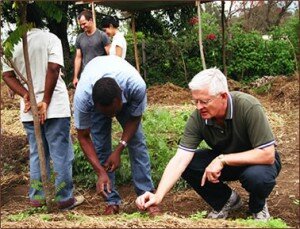The secret to mobilizing and engaging volunteers to bring about sustainable, positive social change…
…is the development of volunteer leaders.
Volunteer leaders provide vision and they inspire, recruit and lead others.
You can play a role in mentoring, coaching and encouraging potential leaders to build the skills they need to take on leadership roles that drive social change.
First, identify individuals who have consistently demonstrated their ability to collaborate and work well with others in productive, long-term relationships.
Through mentoring, you can help new leaders recognize their own ability to manage a team and make effective decisions that result in progress toward objectives, which will improve the community.
Here are eight ways you can develop leaders from within your volunteer ranks:
1. Provide opportunities within your organization for emerging volunteer leaders to develop and practice their skills.
2. Encourage your volunteers to take on challenges that will foster their own growth and development.
3. Make it safe for them to make mistakes by treating them as learning experiences.
4. Support initiatives that your volunteers may come up with themselves rather than insisting on your own (to the degreethat you can). Volunteers will be inspired to pursue efforts and topics that are of particular interest to them rather than what you feel is best.
5. Recognize individuals frequently for their contributions. Recognition that is low-key, frequent and personal is generally more meaningful to people than a big, annual event (although doing both is even better).
6. Send volunteers with leadership potential to a training or take them to conferences.
7. Remind yourself that a progressive increase in responsibility coupled with improved skills helps build leaders.
8. Believe in everyone’s ability to reach higher and achieve more.
Related articles
- 5 Ways to Support Staff Volunteerism (handsonblog.org)
- Tips for Connecting With Your Volunteers (handsonblog.org)
- Five Tips for Making Your Volunteer Program a Part of Your Brand (handsonblog.org)

 What makes people volunteer? This question often runs across the minds of nonprofit organizations when trying to recruit volunteers for service projects. It is important to understand these motivating factors to recruit more dedicated volunteers to your cause. When individuals have a strong tie to your organization, they are more likely to return for service again. They feel that their needs and feelings are being respected when they are included in project planning.
What makes people volunteer? This question often runs across the minds of nonprofit organizations when trying to recruit volunteers for service projects. It is important to understand these motivating factors to recruit more dedicated volunteers to your cause. When individuals have a strong tie to your organization, they are more likely to return for service again. They feel that their needs and feelings are being respected when they are included in project planning. otherwise. This type of reasoning includes “I can make new contacts that might help my business or career “or “Volunteer work will look good on my resume.” It is important for your organization to include the personal benefits to volunteering, as well as the overall community benefits from volunteer work.
otherwise. This type of reasoning includes “I can make new contacts that might help my business or career “or “Volunteer work will look good on my resume.” It is important for your organization to include the personal benefits to volunteering, as well as the overall community benefits from volunteer work.
 Hosting intergenerational projects within your volunteer organization is essential to including the entire community. Often, it can be difficult for organizations to understand older volunteers. It is important to understand older adults and what issues they care about to ensure their participation in your project.
Hosting intergenerational projects within your volunteer organization is essential to including the entire community. Often, it can be difficult for organizations to understand older volunteers. It is important to understand older adults and what issues they care about to ensure their participation in your project. What can your program sell to older Americans?
What can your program sell to older Americans?




 If your organization is still resistant to utilizing social media tools, it is time to catch up with the times. Social media has risen to the forefront for businesses to reach consumers and dedicated audiences nationally and globally. Thanks to social media, you can now better inform others about your organization’s mission, recruit more volunteers, and humanize your organization.
If your organization is still resistant to utilizing social media tools, it is time to catch up with the times. Social media has risen to the forefront for businesses to reach consumers and dedicated audiences nationally and globally. Thanks to social media, you can now better inform others about your organization’s mission, recruit more volunteers, and humanize your organization. with the use of social media. Social media allows your organization to show the communities where it serves while providing immediate answers to questions.
with the use of social media. Social media allows your organization to show the communities where it serves while providing immediate answers to questions.
 become across the internet. It is important to promote your organization’s events, resources, service opportunities, etc. through social media in order for its popularity to grow.
become across the internet. It is important to promote your organization’s events, resources, service opportunities, etc. through social media in order for its popularity to grow.
 We hope these 13 reasons convince your organization to jump on board with social media! You will only benefit from starting a social media plan at your organization.
We hope these 13 reasons convince your organization to jump on board with social media! You will only benefit from starting a social media plan at your organization. items, just to see if I can catch a deal! In addition to finding great deals, book donations allow for low-income families to secure summer reading! Thanks to the YMCA, the Boys and Girls Club, and the Salvation Army, and several other organizations, you can donate your books or schedule your books to be picked up.
items, just to see if I can catch a deal! In addition to finding great deals, book donations allow for low-income families to secure summer reading! Thanks to the YMCA, the Boys and Girls Club, and the Salvation Army, and several other organizations, you can donate your books or schedule your books to be picked up. books such as encyclopedias and dictionaries; 1996 or newer publish date medical, nursing, IT, and law books. Books for Africa also accepts school/office supplies including, paper, pencils, pens, wall charts, maps, etc.
books such as encyclopedias and dictionaries; 1996 or newer publish date medical, nursing, IT, and law books. Books for Africa also accepts school/office supplies including, paper, pencils, pens, wall charts, maps, etc. nteers is an unrealistic goal.
nteers is an unrealistic goal. are able to serve again. Keep in touch with them to let them know that you care about their well-being.
are able to serve again. Keep in touch with them to let them know that you care about their well-being.
 mean more because they are not paid to give it.
mean more because they are not paid to give it.
 It is important to provide inclusive projects for both your volunteers and your staff members to guarantee retention. When volunteers feel their work is both meaningful and fulfilling, they are more likely to return.
It is important to provide inclusive projects for both your volunteers and your staff members to guarantee retention. When volunteers feel their work is both meaningful and fulfilling, they are more likely to return. our national life.”- President Barack Obama
our national life.”- President Barack Obama opportunities should be developed with this idea in mind. Whether your program is designed for neighborhood, community, or world activism, it is important to provide them a sense of fulfillment through service. Make sure that your organization’s mission is clear, so that baby boomers know they are volunteering for a specific cause. Allow older volunteers to form relationships through volunteering, it will make them feel more connected to the project.
opportunities should be developed with this idea in mind. Whether your program is designed for neighborhood, community, or world activism, it is important to provide them a sense of fulfillment through service. Make sure that your organization’s mission is clear, so that baby boomers know they are volunteering for a specific cause. Allow older volunteers to form relationships through volunteering, it will make them feel more connected to the project.

 Today’s post comes from Gregg Michaelsen, Fundraising Consultant at Simple Fundraising Ideas. Gregg specializes in providing
Today’s post comes from Gregg Michaelsen, Fundraising Consultant at Simple Fundraising Ideas. Gregg specializes in providing  banner in the fundraiser’s venue with the restaurant’s information on it.
banner in the fundraiser’s venue with the restaurant’s information on it. You may have started to notice one big event is on everyone’s mind as of late. It’s in your commercials, news, and favorite websites. As the 2012 presidential election draws nearer, and becomes more prevalent in the public sphere, let’s examine what lessons we can learn from national campaigns to aid the nonprofit community.
You may have started to notice one big event is on everyone’s mind as of late. It’s in your commercials, news, and favorite websites. As the 2012 presidential election draws nearer, and becomes more prevalent in the public sphere, let’s examine what lessons we can learn from national campaigns to aid the nonprofit community.
